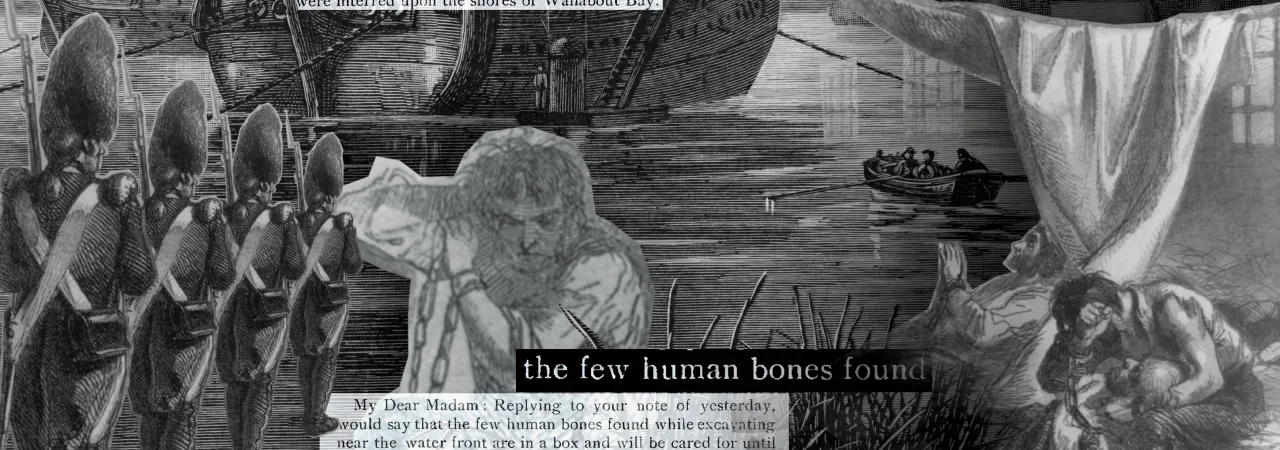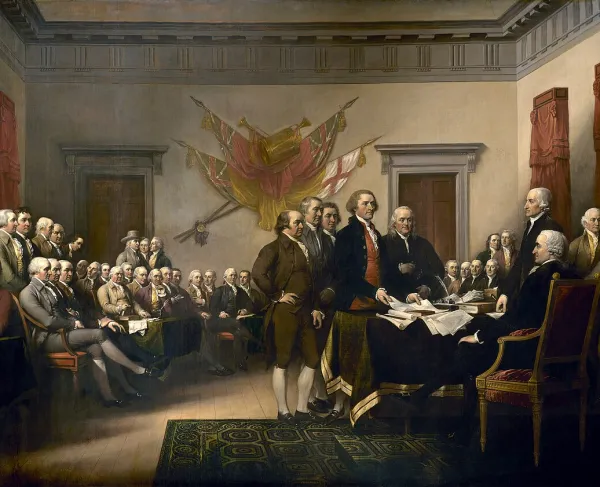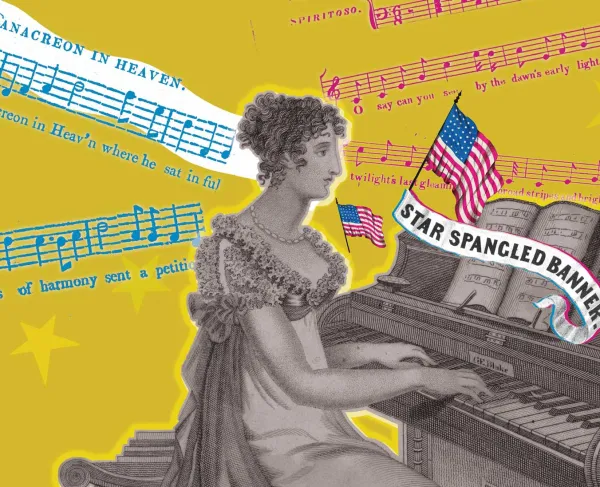
While study of the American Revolution quite often emphasizes the lasting legacies of unalienable rights and our visionary founders, many believe that the bloody battles fought for American independence also left behind specters of a spookier nature. From heroic figures whose presence exceeds their living days to those souls who can’t escape the wicked experiences of war, a lengthy list of paranormal activity can be connected to the nation’s founding conflict. Even if these four chilling tales don’t leave you thinking “Maybe I’ll leave the light on tonight…”you can learn a little bit of new history.
Legends Don't Simply Die
There are those who epitomized the ideas set forth in the fight for independence that are said to still walk amongst us. Commander of the Continental Army and first President of the United States, George Washington is one of them. His ghost has been spotted numerous times in the room where he died at his beloved Mount Vernon. A particular tale, which surfaced during the late 19th century’s interest in spiritualism spike, comes from Josiah Quincy III’s 1806 visit to the renowned residence, which had fallen into the hands of George Washington’s nephew, Bushrod Washington. Narrating the incident, Quincy’s son stated that while staying the night in the Washington bedchamber, his father did indeed see Washington. He postulates that the founding father’s time in the afterlife may have been disturbed by what his father later saw when allowed to enter Washington’s tomb: the “velvet cover of the coffin was hanging in tatters, it having been brought to this condition by the assaults of relic-hunters.” It turns out the revered founder was given little peace after his passing, with the nation’s ongoing craving for remaining fragments of the legendary leader’s life. Perhaps his spirit now rests easier thanks to the preservation work still ongoing at his former home – although some modern staff also report seeing the ghost of Mount Vernon Ladies’ Association founder Ann Pamela Cunningham on the museum grounds.
The Tortured Souls of a Deadly Winter
Many identify Valley Forge, Pennsylvania as the miserable winter encampment of Washington’s Continental Army, but fail to pinpoint the true culprit of freezing despair for the resilient Patriot forces – Jockey Hollow in Morristown, New Jersey. December 1779 marked the beginning of an exceedingly harsh winter in north-central New Jersey in which troops experienced 28 separate snowstorms and saw drifts as high as 15 feet. In January 1780, the temperature only went above freezing once. Major General Johann de Kalb said of his Jockey Hollow stay, “Those who have only been in Valley Forge or Middlebrook during the last two winters, but have not tasted the cruelties of this one, know not what it is to suffer.” And suffer they did. Destitute of funds and scarce of food, soldiers often threatened mutiny. While the location provided the perfect natural defensive work against the British, it amounted to 96 men dead, 1,062 desertions, 140 captured, and 2,735 discharged.
Today, the site is part of Morristown National Historical Park. Run by the National Park Service, it is chock-full of trails and historic markers. Replica huts built in the 1960s mimic the colonial structures that once housed the starving soldiers. Down the hill from these huts is a boulder that serves as a grave marker for roughly 100 soldiers. With an eerie setting and enduring memories of agony, it is no wonder that the location has seen its share of ghost sightings. Hikers, visitors and reenactors have all reported supernatural activity – colonial soldiers marching through dense trees, unexplainable fife and drum music, shadowy figures dashing among the huts, and the translucent apparition of a woman in white carrying a lantern. So, if you ever encounter one of these spirits, make sure not to tell them about the comforts of modern-day heating and insulation.
Bone to be Wild
Often referred to by his irate moniker, General “Mad” Anthony Wayne was an aggressive and seemingly fearless force in combat against the British. He saw his greatest defeat at the overwhelming, defensive Battle of Paoli in September 1777, but was redeemed by his calculated plans, including a daring bayonet charge, that led to success at the Battle of Stony Point in July 1779. His military service extended beyond the Revolution as senior commander in the Legion of the United States during the Washington Administration.
So aside from his disposition in battle, what else is “mad” about Anthony Wayne? Perhaps that he can still be found lurking along U.S. Route 322 as it crosses the Keystone State, searching for his lost bones! “Mad” Anthony was originally buried in Erie, in northwestern Pennsylvania, but his the family wished for his reinterment at their home church graveyard in Radnor, in the southeastern part of the state. So, 13 years after the general’s passing, his corpse was dug up ... and found to be remarkably well-preserved. Faced with earthly remains that had not decomposed as one would expect, the crew In the face of this lack of decomposition, boiled the body was boiled until clean, and with transportable bones remained. These were placed in a box and carted back east, but along the journey, some were rumored to have spilled from the container. Now, the legend concludes, the ghostly general, With a senses that not all is whole and, the legend concludes that the general seeks to collect his skeletal scraps every year on his January 1 birthday.
Let That Sink In
More Patriots’ lives were lost aboard British prison ships anchored along New York’s East River than in battle – between 8,000 - 12,000 died while prisoners of war versus the approximate 6,800 killed in battle. Lost souls included not only American soldiers and sailors, but citizens who opposed the British Crown. Overcrowded in the dark lower decks of the ships, prisoners roasted in sizzling temperatures, drank brackish water supplied through the sides of the ship, starved, and quarreled with vermin, lice, impending madness, dehydration, and contagious disease. It is estimated at that least 6 lives were lost each day on a single prison ship.
Alexander Coffin Jr., an 18-year-old sailor imprisoned on the infamous HMS Jersey, wrote, “I soon found that every spark of humanity had fled the breasts of the British officers who had charge of that floating receptacle of human misery; and that nothing but abuse and insult was to be expected.”
The bodies of many who perished were simply tossed overboard, leaving remains to gradually wash up along Brooklyn’s shore; others were buried in shallow graves on the beaches adjacent to the anchored ships, where, susceptible to shifting sand, they too were exposed to the elements and the horrified eyes of their comrades. For years after abandonment of the ghastly vessels, Brooklynites collected exposed remains of these tortured prisoners for proper burial – eventually within a crypt in Brooklyn’s Fort Greene Park. To honor their memory, the Prison Ship Martyrs’ Monument was dedicated in 1908 by President-elect William Howard Taft.
Despite efforts to preserve the memory of those lost aboard ship, some souls remained without peace. In October 1902, laborers at the Brooklyn Navy Yard stumbled upon the sunken hull of the Jersey, accidentally piercing it while extending one of the docks. Soon after, nearby residents reported strange activity, including that of faint whispers near the water. So, beware… the next time you’re walking along New York’s northwest shore you may be greeted by the lingering souls of the steadfast Patriots whose dreams were abruptly sunk and lives were unbearably lost.





